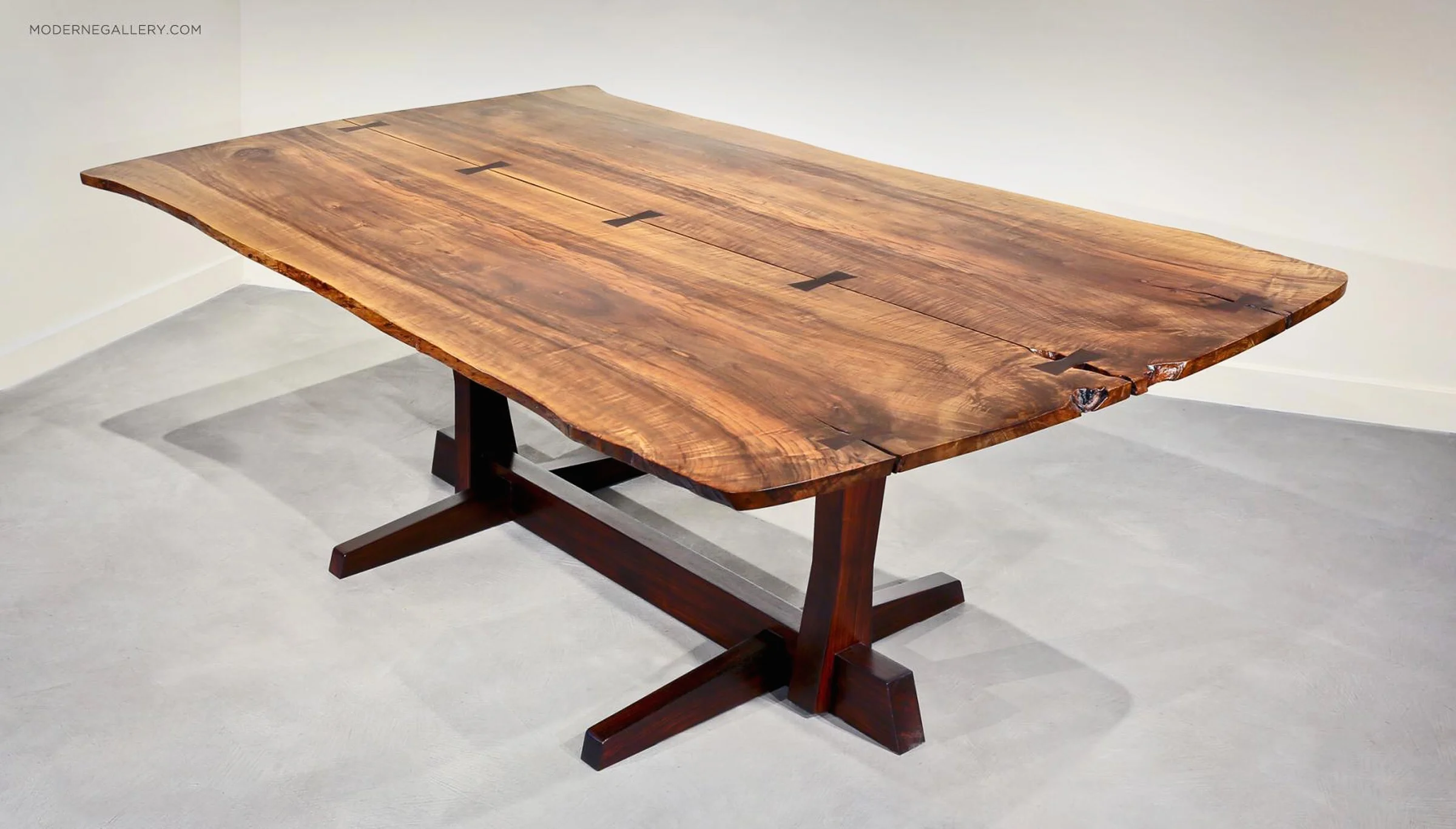Like many woodworkers, I was early on wooed by the design aesthetic of George Nakashima - a natural-born American, of Japanese heritage, who worked through the middle of the 20th century. Though Nakashima is well-known among woodworkers, and his work often copied, he may not be as well-known among the common public, so I wanted to put a few words about him here. Born in Spokane, Washington, in 1905, Nakashima started out as an M.I.T. trained architect. He ended up working under an esteemed Japanese architect in Japan, which allowed him to study traditional Japanese design. This work carried him to India, where he designed and oversaw the building of an ashram's dormitory. Nakashima became involved in the spiritual community there, and probably developed some of his ideas on the spirituality in trees, which he would lay down in his influential book: The Soul of a Tree: A Woodworkers Reflections. Nakashima also designed and built some of his first furniture for the ashram.
Eventually, Nakashima returned to the U.S., and during the second World War, he along with other Japanese-Americans, were placed into internment camps. While this was a devastating time for Japanese-Americans, it was here, under the direction of a traditional Japanese carpenter, that Nakashima came to develop his skills as a woodworker. He was later released from the internment camp, at the behest of Antonin Raymond (a famous Czech-American architect), who Nakashima had previously trained under, and Nakashima took his family to live in that man's rural Pennsylvania studio at New Hope. This is where he would setup his studio and develop the designs that would alter the course of modern American furniture.
Nakashima's work was fairly unique when it arrived on the scene. His use of the live-edge, most often in table-tops or surfaces, against an otherwise delicate and dimensional design, seemed to bridge and represent a modern gap between the random, flawed beauty of nature, and the predictable precision of human design. He is often quoted by woodworkers, when they say something like, 'I like to let the wood speak for itself.' Nakashima felt that after a long life as a tree, its spirit could live again, and become again useful, in furniture, and that it retained a voice in what it was to become. Each slab was carefully chosen for the commissioned piece, and each flaw or feature was put on stage, rather than hidden. To this end, Nakashima made famous the use of butterfly joints, which stitched together cracks in the lumber - that is, features which may have been sawn away by another woodworker. This technique, or philosophy, of glorifying what would otherwise be thought of as a flaw, is reminiscent of the Japanese practice of Kintsukuroi, meaning Golden Repair, which refers to the repair of pottery in a manner which puts on display the repair, rather than hiding it.
Essentially, Nakashima brought the live-edge into the realm of fine furniture. While developing a style that paid homage to traditional Japanese woodworking, Nakashima's designs were also firmly rooted in the American tradition. His rocking chairs are a good example of this, which are clearly influenced by the Windsor chair, an American invention, while retaining the delicate simplicity of traditional Japanese design. American Shaker design, in particular, was a large influence on Nakashima, and it's no wonder that Shaker design is often compared to traditional Japanese design - both put a premium on simplicity and utility, while forgoing excessive ornamentation. This common thread, which Nakashima found and cultivated, lies at the heart of his genius.
Nakashima passed away in 1990, but his workshop, now operated by his daughter, Mira, continues to produce her father's original designs, as well as new designs by herself. She also authored a great book about her father, Nature Form and Spirit: the Life and Legacy of George Nakashima, which is a good resource if you want to know more about the life of the man behind the work. His original furniture currently sells for a fortune - check it out on 1stdibs.com.
George Nakashima was a giant in the world of furniture design, and his work is often imitated, by myself included. If you go check out the Work section of this site, you'll find a bed I did recently, that very intentionally borrowed its voice from Nakashima. Of all things I have taken from Nakashima, it is his reverence for the material that I try most to imitate. Trees play a vital role in the eco-system of our world, and we are coming to understand them as creatures more complicated than we give them credit for, which is why we are committed to acquiring trees that have been removed sustainably; that is, trees that are dying, have come down in a storm, etc, or must necessarily be removed. I believe that if you have a supreme respect for the material: how it is acquired, selected, and finally worked, the resulting piece will surely be full of beauty and meaning.
Below are a few examples of Nakashima's furniture:









